The X Button
Infinite Test
by Todd Ciolek,

Welcome to another edition of the X Button. We begin with a shocking tale of censorship involving the recent Atlus release of Trauma Team. You may wish to send your children out of the room.
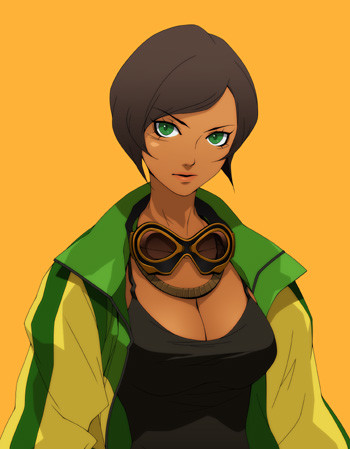
This is the official artwork of Trauma Team's hotheaded paramedic Maria Torres. You will likely note her low-cut top, which would violate the dress code at any professional medical establishment.
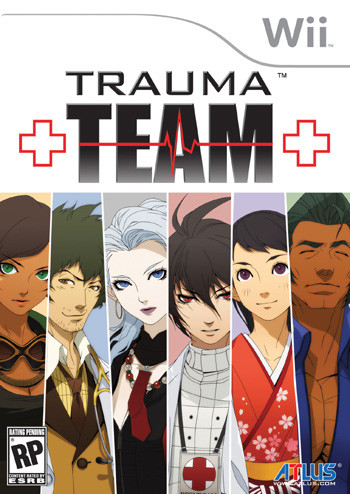
This is the cover of the U.S. version of Trauma Team, with Maria shown on the far left. Look closely, and you'll see that the artwork was modified to expose less of Maria's chest. The same thing was done to the outfit of Naomi, the white-haired woman at the center of the cover. This is, of course, a scandalous crime against the fictional personages of these women, the artistry of Shigenori Soejima, and the whole development staff of Trauma Team.
Seriously, this is none of those things, and no one should be outraged. At most, we should be amused that someone saw fit to spare prospective Trauma Team buyers the sight of a few centimeters of cartoon cleavage. After all, the game's print ad has an uncensored Maria front and center, while the game itself is rated T and shows Maria occasionally wearing a lot less.
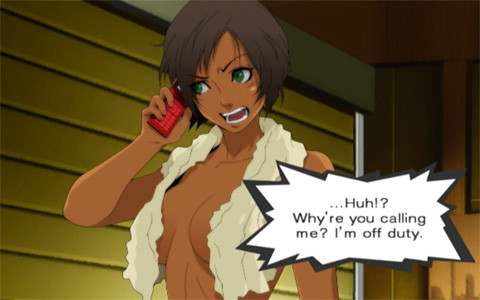
This also raises the question of how Trauma Team was handled over in Japan. Was Maria's outfit downplayed on the cover of the Japanese release? The answer, if you know anything about Japan's game industry, is obvious.

Of course it wasn't.
NEWS
HARD CORPS: UPRISING IS CONTRA, SERIOUSLY
Arc System Works is making a Contra game. That sentence is so right that I almost don't want to elaborate. Even though Arc System Works has a limited and dodgy history when it comes to action-shooters, they're still the developer behind the manic 2-D fighting of Guilty Gear and BlazBlue. And even though the game isn't technically a Contra title, it's inspired by Contra Hard Corps, the best of the series.

In fact, Hard Corps: Uprising is a prequel to the game we all knew as Contra: Hard Corps on the Sega Genesis, and one of its two playable characters, Bahamut, was actually the villain in the original game. Uprising follows a younger version of Bahamut and a soldier named Krystal (she's called “Christer” in these early screens, and I really wish they hadn't changed that) as they fight through various stages that scream Contra: lots of enemies, devastating power-ups, and the return of Contra's first-stage boss. It all looks quite modern, of course, pairing 3-D backgrounds and 2-D characters to resemble Sammy's now-forgotten Dolphin Blue arcade shooter. Bahamut and Krystal get the usual Contra recruit's abilities, plus some Guilty Gear-like air dashing and the ability to reflect enemy projectiles.

The game even reflects the difficulty of the original Hard Corps, which used a life meter in its Japanese release and stuck to a one-hit-and-you're-dead challenge in the American version. Uprising has an “Arcade” mode that has players clinging preciously to one-hit frailty, while the “Rising” mode lets Bahamut and Krystal take more damage. Uprising's out later this year for Xbox Live and the PlayStation Network.
GOLDEN SUN: DARK DAWN KEEPS TRADITIONS ALIVE
The Golden Sun series is low-key for something backed by Nintendo, perhaps because even the games' fans admit that they're generic RPGs in plot and appearances. But the Golden Sun titles also sport dependable play mechanics, and the new Dark Dawn extends that to the DS. It introduces a warrior named Matthew, a magic-using woman named Karis, and a lumbering heavy named Terrell, all of whom appear to be new to the Golden Sun franchise.

As the first Golden Sun on the DS, Dark Dawn introduces stylus-based puzzles to the game's stages, where Matthew uses fire, telekinesis, and other spells to clear paths through caverns and mountains. It's been a common device in RPGs since the days of Lufia II and Wild Arms, but it's always good when a game's “dungeons” are more than just hallways and doors. Battles are once again turn-based and once again involve summoning Djinn for extra-powerful attacks, though those battles are now 3-D in their looks. And there's a robot.
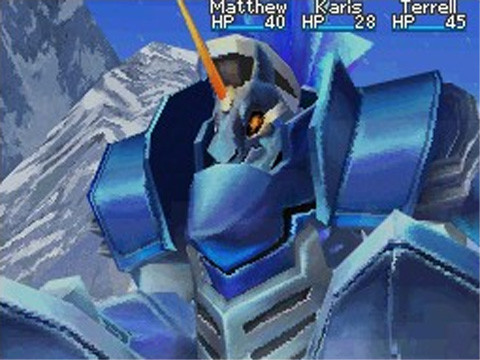
Camelot's at least made Golden Sun: Dark Dawn pretty as far as DS-based RPGs go. And yes, it's a regular DS game, and not one of those fancy new 3DS things. Dark Dawn's expected by the end of the year in the U.S.
PARASITE EVE'S 3RD BIRTHDAY STANDS OUT
The Parasite Eve spin-off The 3rd Birthday has slowly grown more interesting. It was first announced as a cell-phone game that would likely not be released outside of Japan, but then Square Enix moved it to the PSP and broadened the game's ambitions. The 3rd Birthday is now a third-person shooter, visibly reminiscent of the previous two Parasite Eves. Square Enix is cagey about the game being a side-story instead of a true Parasite Eve 3, but look at it. It has the same sort of mutating enemies, the same modern-day setting, and the same blonde heroine: former police officer Aya Brea.
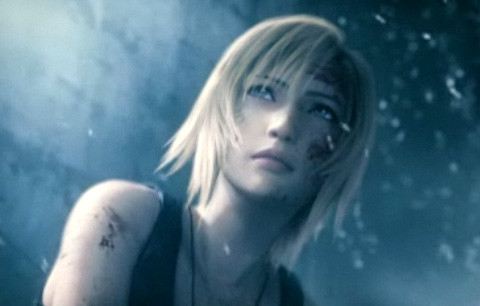
The most interesting detail revealed so far is The 3rd Birthday's body-switching system, which lets Aya hijack nearby allies and effectively leap into their bodies like she's Scott Bakula or something. It's an interesting mechanic, underused since the days of Jaleco's Avenging Spirit, even though it wasn't emphasized in the game's admittedly short E3 trailer. We'll learn more about it soon, as Square's promising a 2010 release.
REVIEW: DISGAEA INFINITE
 Developer: Nippon Ichi Software
Developer: Nippon Ichi Software
Publisher: NIS America
Platform: Sony PSP
Players: 1
MSRP: $19.99
Disgaea was a burst of fresh air back in 2003, when its mocking, overblown take on the strategy/RPG arrived in a staid, unremarkable realm of role-playing cliché. Disgaea shook out the old guard, made fun of itself and everything else in its genre, and effectively started the whole trend of American companies releasing games with huge-eyed characters and unadorned 2-D graphics, two things long considered sales-chart suicide in the West. That was seven years ago, and a lot what Disgaea did is now commonplace among the RPGs peddled by NIS America, Aksys, Xseed, Ignition, and other publishers, leaving the series to branch out with the side-scroller Prinny: Can I Really Be the Hero? and crossovers like Trinity Universe. Even in these spin-offs, Disgaea sells itself on its charm and comedy, and that's what drives Disgaea Infinite.
The netherworld of Disgaea is one of cutesy cynicism, a place where the lord of hell is an obnoxious little munchkin named Laharl. He's accompanied by his conniving vassal Etna, a legion of explodable demon-penguin Prinnies, and the squeaky-voiced Flonne, a novice angle who's too nice for her own damn good. Laharl hates pleasant things, Etna's always a step away from deposing him, Flonne thinks the best of everything, and the trio is often interrupted by Earthling do-gooders Captain Gordon, his sidekick Jennifer, and their pet robot Thursday. And, no matter what happens, Prinnies are the cursed souls of the netherworld, abused so often that even the apparent good guys beat up on them.
As a visual novel, Disgaea Infinite doesn't change this stage much. Everyone's still hateful and delusion, and after a failed assassination attempt, Laharl angrily cuts the already-meager salaries of his Prinny hordes. One distraught Prinny stumbles across Tick-Tock, a demonic timepiece that can send said Prinny's soul back in time. There, the Prinny relives the hours right before the assassination attempt, watching as Laharl, Gordon, and everyone else bumbles around.

Nippon Ichi Software openly borrows Disgaea Infinite's idea from one of their earlier and Japan-exclusive games: Infinite Loop, in which a dead prince solved a mystery by possessing characters with his wayward spirit. In Disgaea Infinite, our heroic, already-dead Prinny has the same ability, as he can spiritually control every major Disgaea character, following their distinct plotlines and guiding their actions at certain points. Under the Prinny's command, everyone can pull out-of-character responses to certain questions, throwing the past plotline wildly out of joint.

Of course, a simple evening around the netherworld castle is a complicated web of conspiracies and disasters, and unraveling the whole thing requires considerable replaying of the same story. There's a branching network of subplots and character paths to follow (and then another network after that), and it all gets quite repetitive. The game tries to ease the return trips: you can speed through dialogue and revisit earlier plotlines by saving. Yet it doesn't change the fact that you're forced to review the same scenes time and time again. In order to keep the game manageable, the Prinny's soul can jump characters any time, but its chances to actually change their actions are somewhat limited.
Disgaea Infinite has a clear solution, even with its multiple endings and paths, and it's frustrating to know exactly what to do, but not how to do it. At the risk of spoiling things, the assassination attempt on Laharl is an accident involving pudding and switched packages, and its solution is obvious early on. Yet possessing Laharl doesn't give you the option of, say, not eating the booby-trapped mechanical pudding, and you're forced to seek a more elaborate solution. It's like that throughout the game, as the player is powerless to directly change things until they work through the game's engine of plot arcs and soul possession.
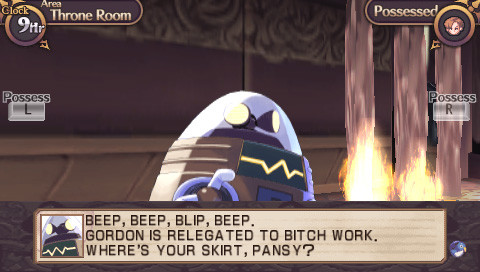
Being little more than storyline, Disgaea Infinite relies heavily on its weird cast and fourth-wall breaking, and it succeeds only halfway. There's a share of amusing references and entertaining absurdity, but an awful lot of Disgaea's humor is stale. Fans of the series have seen the same jokes many times over: Etna and Flonne are sensitive about their figures (which is rather creepy, considering their childlike appearances), Laharl has an aversion to buxom women, Gordon and Jennifer are sort of clueless, and, of course, Prinnies get smacked around for no reason. Most of this humor was hackneyed even when Disgaea was new, and Disgaea 3's Mao and Raspberyl don't add much to Infinite's comedy. Despite its mockeries of the game industry and nerd culture, Infinite's attempts at getting laughs are best summed up by its opening joke about Etna's flat chest.
Disgaea Infinite's set up much like any other visual novel, with character portraits, text, and dialogue conveying a lot of the game. NIS also throws in occasional scenes of animated character sprites, as they quibble and unleash the same sort of over-the-top attacks that they did in the full-fledged strategy/RPG Disgaeas. For a game that leans so heavily on voice work, it's a blessing that Disgaea Infinite gets solid performances. The cast members from prior Disgaeas reprise their roles, with Sandy Fox squeaking her way through Flonne's part and Michelle Ruff pouting it up as Etna. Of course, you'll be hearing those voices a lot as you cycle through the game's often-repeated plot arcs and gags.
It's that repetition that confines Disgaea Infinite to a life of limited appeal. It's strictly for the already devoted Disgaea fans, as the game's recycled story, confined playfield, and often tired humor bury the genuinely amusing moments. Disgaea needs gameplay, even if it's yet another RPG or a side-scrolling action game like the upcoming Prinny 2. Disgaea may still have legs in today's RPG market, but Infinite shows that it can't get by on personality alone.
NEXT WEEK'S RELEASES
DEATHSMILES LIMITED EDITION Developer: Cave
Developer: CavePublisher: Aksys Games Platform: Xbox 360 Players: 1-2 MSRP: $49.99 Deathsmiles is important for one reason: it's the first Cave shooter to get an official console release in North America. Cave's spent over 15 years putting out well-made shooters in Japan, but they're never made their way over here (the iPhone version of ESP Galuda II doesn't count). And while Deathsmiles wouldn't be my first choice for U.S. release (that'd be the aforementioned ESP Galuda II), it's a fine example of what made Cave a big name in the small shooter market. Deathsmiles hurls five girls, clad in the height of borderline-unnerving gothic-lolita fashion, through side-scrolling levels full of colorful bullets and the Victorian-themed monstrosities that spew them. Unlike a lot of horizontal shooters, Deathsmiles attacks the player from both sides, forcing characters to dodge expertly and make the most of their personalized attacks. Cave also revamped the game for its Xbox 360 debut, as there's a Mega Black Label version of the game, touched-up graphics, and an option to directly control the animal sidekick of one's chosen character. Aksys also deserves credit for packaging their release of Deathsmiles: what was downloadable in the Japanese version of the game is now on the U.S. disc for free, and it all comes with a soundtrack and one of those fancy Xbox 360 faceplates.
|
NINETY-NINE NIGHTS 2 Developer: Q Entertainment/Feelplus
Developer: Q Entertainment/FeelplusPublisher: Konami Platform: Xbox 360 Players: 1-2 MSRP: $59.99 Ninety-Nine Nights 2 is nothing if not a reflection of the modern game industry. The original Ninety-Nine Nights was a battlefield brawler with hordes of enemies and flashy, Dynasty-Warriors attacks, though a cartoonish quality came through here and there, especially in a witch straight out of the Uncanny Valley. Ninety-Nine Nights 2 makes everything gloomier, meaner, and more visually bleak. The game still demands much carving-up of enemies on the battlefield, but encounters with huge bosses close many of the levels, proving that God of War's success left few games untouched. The storyline continues in its affection for divided loyalties, as the player gets to see a massive war between humans, goblins, and other races through the eyes of five different characters. And while those characters are still the usual complement of anime archetypes and fantasy-novel tropes, they're all just a little darker in theme this time around.
|
SIN AND PUNISHMENT: STAR SUCCESSOR Developer: Treasure
Developer: TreasurePublisher: Nintendo Platform: Nintendo Wii Players: 1-2 MSRP: $49.99 One could argue that Treasure's sold out for the past seven years: the developer that spent the 1990s noticeably not making sequels now makes mostly sequels or licensed games. Yet I'll defend all of Treasure's sequels to their past successes as they're exceptionally fun games. Yes, even Advanced Guardian Heroes. Sin and Punishment: Star Successor is Treasure's most ambitious sequel yet, as the others were 2-D games on more primitive hardware. Star Successor is a 3-D rail shooter (think Space Harrier, Panzer Dragoon, and other run-into-the-screen action games) for the Wii, and it's brimming with the sort of design extravagance that made Treasure famous. Bosses lumber along, transform, and hurl all sorts of narrowly dodgeable attacks, while the player's armed with only a simple targeting crosshairs, a handgun, and a bullet-reflecting sword. There's another bizarre, Treasure-caliber storyline at work as well, as the game has teenage rebels Isa and Kachi fighting through an army that includes giant fish, morphing chimeras, swordswomen, and other free-association bosses. There's also a two-player mode, though the second participant is represented only by another crosshairs on the screen.
|
TRINITY UNIVERSE Developer: NIS/Gust/Idea Factory
Developer: NIS/Gust/Idea FactoryPublisher: NIS America Platform: PlayStation 3 Players: 1 MSRP: $49.99 It might be hard to tell Trinity Universe apart from the other games that mix up characters from niche Japanese RPGs developers Gust, Nippon Ichi Software, and Idea Factory. After all, the three companies announce a new crossover title every Friday. But we can keep track: Trinity Universe isn't like X-Edge, which had Capcom's Darkstalkers series involved. And Trinity Universe isn't Super Dimension Game Neptune, which has far more abstract personifications of various game systems and companies. Trinity Universe mixes in characters from Gust games and the NIS-fed Disgaea franchise, with a plot that reaches into the cartoony underworld of Disgaea and the less hellish realm of Gust's Atelier series. It also breaks from its crossover kin by sticking to the dungeon-exploring and battle interruptions of a traditional RPG, instead of the strategic grids of many NIS games. It does it all in 3-D as well, putting characters like Etna and Flonne from Disgaea into flashy combat alongside…uh, some characters from the Atelier games. Of course, Trinity Universe adds some new faces, including the valkyrie Rizelea and the abdicated demon king Kanata. Don't count on seeing them again. Well, not unless there's a Trinity Universe 2.
|
discuss this in the forum (33 posts) |
this article has been modified since it was originally posted; see change history